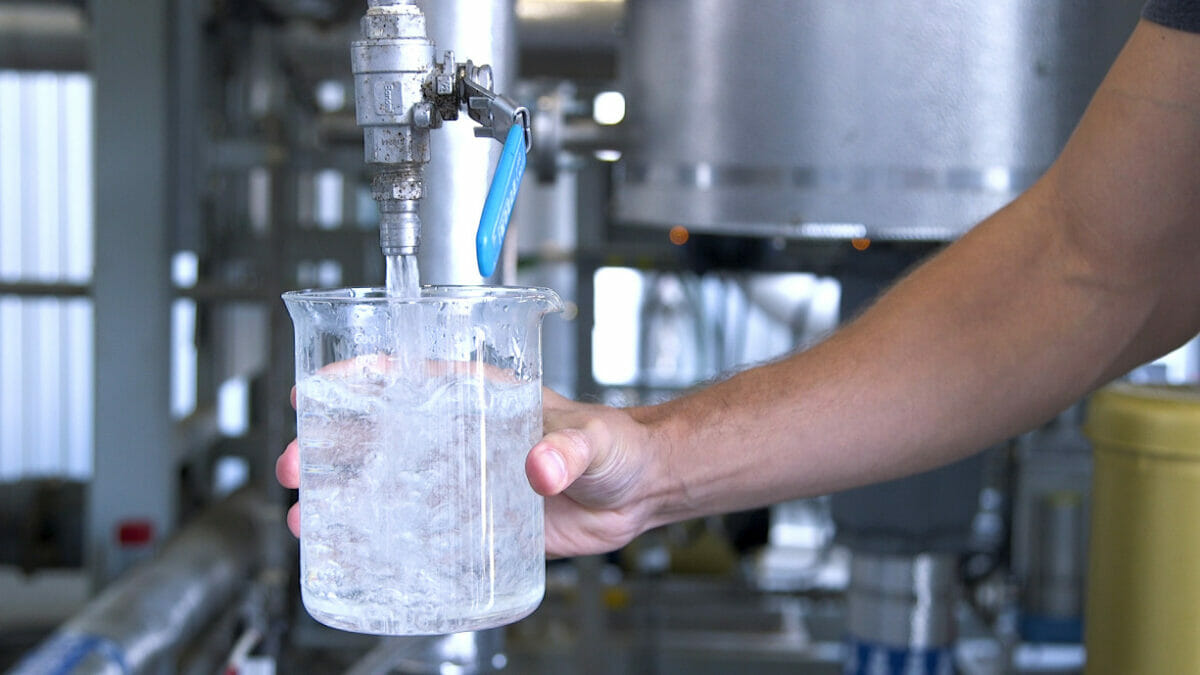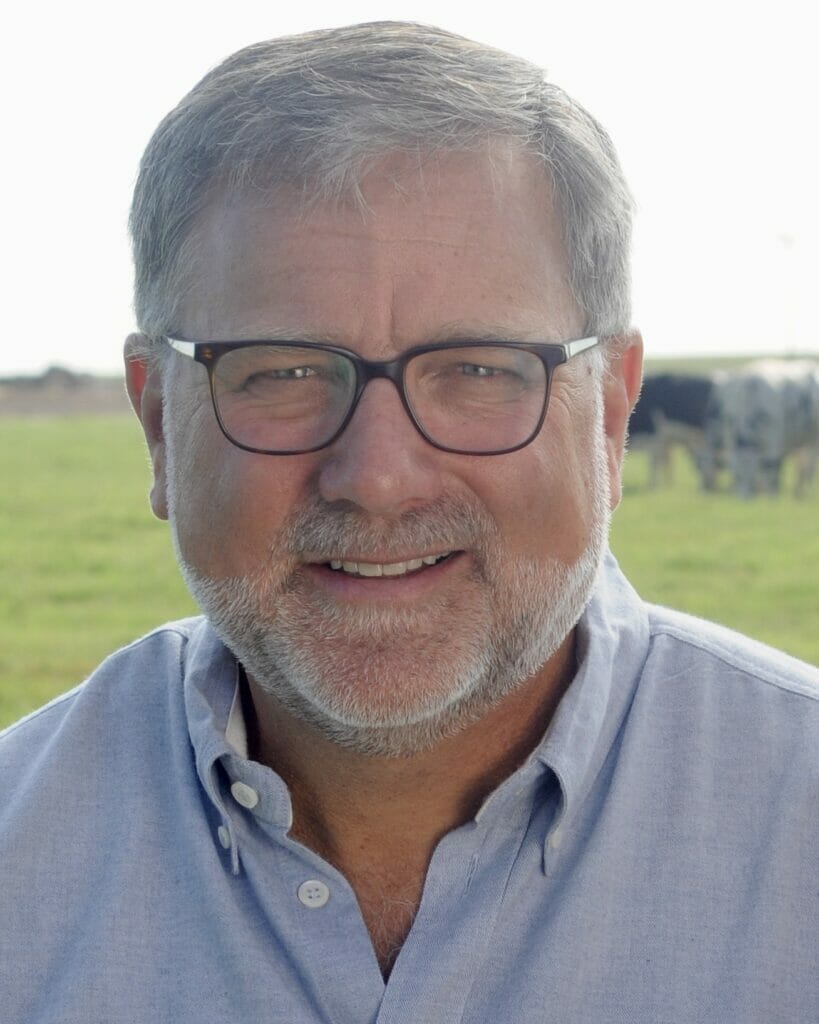Meet the Modern Farmer Turning Manure Into Water
Why one Texas dairy farmer is going all in on cow waste.
Meet the Modern Farmer Turning Manure Into Water
Why one Texas dairy farmer is going all in on cow waste.

New technology transforms cow manure into clean water and dry organic fertilizer.courtesy of Natural Prairie Dairy.
There has to be a better way to do this.
That’s what Donald DeJong thought to himself over and over, working on his farm, Natural Prairie Dairy, in the Texas Panhandle. From sourcing organic fertilizer and trucking it all over his acreage to dealing with weeds and issues with the lagoons that dotted his land, the whole system just seemed inefficient. It needed an overhaul.
DeJong has been a dairy farmer for more than 20 years, with the majority of that time focused on organic dairy. He and his wife started with 800 heads of cattle. Now, they have more than 3,500 cows and have expanded to a second ranch in Indiana. As his business kept growing, DeJong kept coming back to that thought: Is there a better way to do all of this?
“The biggest concern was how do we get a better source of organic fertilizer,” DeJong recalls. Like many dairy farmers, the DeJongs were using lagoons on their farm to safely hold the nitrogen and ammonia that naturally occur in the heaps of manure their cows produced on a daily basis. But letting all of that nitrogen literally evaporate into thin air was frustrating to DeJong. “That’s fertilizer. If we could figure out a way to capture that nitrogen, that was a big motivation.”
So, DeJong started looking around and found Sedron Technologies. Its Varcor system takes that manure and extracts the valuable nutrients, creating a steady stream of fertilizer and potable water at the same time. He flew to Washington to meet the team, where he found himself in a room full of engineers. “I was taken aback; there were over 20 engineers in that room. And we were talking about manure. I’ve never been in a place with that much brain power in one room, with the ability to say, ‘Let’s solve this,’” says DeJong, who signed on to act as a beta tester, putting the Varcor system to work on his farm.
While DeJong says the machinery can get a bit technical to run, with training, it’s easy to use. The manure goes in one end and water comes out the other. The process should be familiar to dairy farmers that use vapor compression to make dry milk powders.
“The liquid goes in, and we take the large fiber out, as there’s not a nutrition value or fertilizer value there. Then that liquid is heated almost to a boiling point,” explains DeJong, at which point condensation starts to collect. That vapor is captured and recompressed into liquids, creating one stream of distilled water and another of aqueous ammonia. The solids that are left over from the “bake” are a concentrated mix of phosphorus, nitrogen and potassium—the three key components of fertilizer.

DeJong takes the dry powder and the aqueous ammonia, stabilized with ammonia nitrate, and uses it on his corn and alfalfa fields as concentrated, weed-free, organic fertilizer. In the face of ongoing fertilizer shortages, producing his own nitrogen has changed how DeJong approaches farming. “And then your clean water comes out, too. It’s beautiful clean water, and we’re upcycling all that stuff coming in,” he says. The farmer then uses the water to irrigate those same crops, creating a much more integrated system.
The Varcor system is a big piece of machinery, filling an entire tractor shed. It’s designed for at least a 3,500-head herd and can process about 110 gallons of input a minute. And with a machine that large comes an equally large price tag. DeJong says the initial investment is about $10 million, although he notes that it also comes with maintenance and tech support.
That’s a lot of money upfront for most farmers. But DeJong is so enamored with the system that he and his wife bought a stake in the company that makes it. He believes that being able to use vapor compression on manure to extract clean water and nitrogen concentrates has the potential to revolutionize the dairy industry—especially in the face of detrimental droughts.
“I am so bullish on this. I think it’s going to capture over half of the industry, for sure. You’re going to be looking at swine operations, poultry operations as well,” DeJong says. Right now, Sedron Technologies, along with DeJong as an enthusiastic spokesperson, is looking to set up six more units over the next year, spread out across Indiana, Texas, Wisconsin and Florida. After that, the goal is to commission a few machines each month.
It’s a tall order, but DeJong thinks that, within five years, this technology will be more accessible to farmers across the country. “It’s scalable,” he says. “And it’s going to transform the backside of animal agriculture for the better.”
Follow us

This work is licensed under a Creative Commons Attribution-NoDerivatives 4.0 International License.
Want to republish a Modern Farmer story?
We are happy for Modern Farmer stories to be shared, and encourage you to republish our articles for your audience. When doing so, we ask that you follow these guidelines:
Please credit us and our writers
For the author byline, please use “Author Name, Modern Farmer.” At the top of our stories, if on the web, please include this text and link: “This story was originally published by Modern Farmer.”
Please make sure to include a link back to either our home page or the article URL.
At the bottom of the story, please include the following text:
“Modern Farmer is a nonprofit initiative dedicated to raising awareness and catalyzing action at the intersection of food, agriculture, and society. Read more at <link>Modern Farmer</link>.”
Use our widget
We’d like to be able to track our stories, so we ask that if you republish our content, you do so using our widget (located on the left hand side of the article). The HTML code has a built-in tracker that tells us the data and domain where the story was published, as well as view counts.
Check the image requirements
It’s your responsibility to confirm you're licensed to republish images in our articles. Some images, such as those from commercial providers, don't allow their images to be republished without permission or payment. Copyright terms are generally listed in the image caption and attribution. You are welcome to omit our images or substitute with your own. Charts and interactive graphics follow the same rules.
Don’t change too much. Or, ask us first.
Articles must be republished in their entirety. It’s okay to change references to time (“today” to “yesterday”) or location (“Iowa City, IA” to “here”). But please keep everything else the same.
If you feel strongly that a more material edit needs to be made, get in touch with us at [email protected]. We’re happy to discuss it with the original author, but we must have prior approval for changes before publication.
Special cases
Extracts. You may run the first few lines or paragraphs of the article and then say: “Read the full article at Modern Farmer” with a link back to the original article.
Quotes. You may quote authors provided you include a link back to the article URL.
Translations. These require writer approval. To inquire about translation of a Modern Farmer article, contact us at [email protected]
Signed consent / copyright release forms. These are not required, provided you are following these guidelines.
Print. Articles can be republished in print under these same rules, with the exception that you do not need to include the links.
Tag us
When sharing the story on social media, please tag us using the following: - Twitter (@ModFarm) - Facebook (@ModernFarmerMedia) - Instagram (@modfarm)
Use our content respectfully
Modern Farmer is a nonprofit and as such we share our content for free and in good faith in order to reach new audiences. Respectfully,
No selling ads against our stories. It’s okay to put our stories on pages with ads.
Don’t republish our material wholesale, or automatically; you need to select stories to be republished individually.
You have no rights to sell, license, syndicate, or otherwise represent yourself as the authorized owner of our material to any third parties. This means that you cannot actively publish or submit our work for syndication to third party platforms or apps like Apple News or Google News. We understand that publishers cannot fully control when certain third parties automatically summarize or crawl content from publishers’ own sites.
Keep in touch
We want to hear from you if you love Modern Farmer content, have a collaboration idea, or anything else to share. As a nonprofit outlet, we work in service of our community and are always open to comments, feedback, and ideas. Contact us at [email protected].by Emily Baron Cadloff, Modern Farmer
June 18, 2022
Modern Farmer Weekly
Solutions Hub
Innovations, ideas and inspiration. Actionable solutions for a resilient food system.
ExploreExplore other topics
Share With Us
We want to hear from Modern Farmer readers who have thoughtful commentary, actionable solutions, or helpful ideas to share.
SubmitNecessary cookies are absolutely essential for the website to function properly. This category only includes cookies that ensures basic functionalities and security features of the website. These cookies do not store any personal information.
Any cookies that may not be particularly necessary for the website to function and are used specifically to collect user personal data via analytics, ads, other embedded contents are termed as non-necessary cookies.
I am interested in this concept and eager to know more
Best article of the day I read, I appreciate you sharing this information. I will visit your website often.
Amazing!
Thank you for sharing this amazing idea. I like this idea. Unfortunately, the amount of drinking water in our world is really limited, and I believe that we can somehow make it past the stage. It’s cool that we are starting to extract water from improvised means. This is primarily a question that will directly affect our health with you.
Unfortunately we really don’t know the long term health factor this could cause. Farmers are always looking for a cheaper way to save and they should. However, we really do not know why people are sick with cancers, viruses, and other diseases! Can’t always jump on board with everything, especially without a much thorough, and well established long term study of the effects on human beings. NOPE!!!
I will need to find out more about this and in the meantime be very careful about who and where I buy food; especially if this is the way things are going….too risky!
so respect
Wow! This blog post is an absolute gem! The content is well-researched and beautifully articulated.
Unfortunately, the amount of drinking water in our world is really limited, and I believe that we can somehow make it past the stage. It’s cool that we are starting to extract water from improvised means. Seabedee This is primarily a question that will directly affect our health with you.